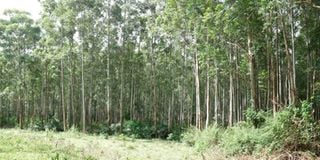Premium
Climate fact check: Where does the rain really come from?

Part of the tree cover at the 104 hectares Nyangweta forest in South Mugirango in Kisii county. Scientists detail that the rain that pours down is the end product of various processes in which trees are heavily involved.
In the past, before the era of technology, our ancestors believed that rain came from a pool of water beyond the skies, after all, where would it be tumbling down from? This pool, they thought, must have been firmly barricaded by a firm barrier, which had small openings to allow the rain to drop down.
Centuries later, when scientists linked rain and availability of water to trees, there are still some skeptics who, like our ancestors, believe that rain comes from the sky and has no link to trees.
Take for example a tweep, who, following a story by the Nation about wells and rivers drying up because of felling of trees in Mt Elgon, took to twitter saying: “Mvua hutoka juu sio kwa miti” (rain comes from the sky, not trees).
Scientists, however, detail that the rain that pours down is the end product of various processes in which trees are heavily involved.
Trees/forests release moisture into the atmosphere through a process called transpiration, in which water moves through a plant and evaporates from its leaves, stems and flowers. This reduces the temperature of the air, resulting in creation of low pressure zones.
“Heat causes expansion, meaning that a hotter quantity of atmosphere will expand and push itself into a colder area (this is why city streets and deserts provide such great updrafts for birds to fly with). This transference of atmosphere from one area to another will bring whatever moisture is on the wind as it rushes in to fill low-pressure areas. This means that whatever area is evaporating more — creating a low pressure zone by lowering air temperatures — is going to attract moisture from adjacent lower-evaporation areas,” reads an article by American Forests.
This phenomenon, scientists have observed, is at heavy play in the Amazon forest, and has convinced scientists that Amazon forest has the ability to make its own rain, which often begins two or three months earlier than everywhere else in Latin America.
Academics from the university of California used NASA’s Aura satellite to study water vapours over the Amazon rainforest, and realised that when the dry season is ending , clouds build over the southern amazon. The clouds are from water vapour from the forest, consistent with transpiration, which releases more moisture than that from evaporation in the region.
In another study, scientists from the University of Queensland found out that areas where there was deforestation experienced reduced rainfall and higher temperatures.
“It also revealed large-scale reforestation increased rainfall, with more trees making more rain which grew more trees, and so on. A 2015 review by Deborah Lawrence and Karen Vandecar in Nature Climate Change found evidence from global climate computer models that critical thresholds exist for the Amazon rainforests where deforestation of more than 30-50 percent caused rainfall and ecosystems to significantly decline,” says World Wide Fund for Nature (WWF).
“From the Amazon to the Congo, West Africa to India, major deforestation has been observed or modelled to make the local weather hotter, drier and windier. This agrees with what wise people in rural and regional Australia will tell you. Forests make rain, and clearing trees reduces rainfall and heats air temperatures. So by allowing even more tree clearing, State governments and lobbyists harm rural and regional communities’ climate and economic future. It ignores meteorological and ecological research that deforestation lowers rainfall, raises temperatures and increases drought risk, and ultimately causes desertification,” adds WWF.
A study published in Trends in Plant Science showed that trees produce water vapour that may be 10 times more than that produced by herbaceous vegetation per unit of land area. The study also states that transpiration may contribute up to “90 per cent of moisture in the atmosphere derived from land surfaces.
“Deforestation breaks the cycle, disrupting precipitation and making it more variable, not only by reducing transpiration and cloud formation, but also by slowing or disrupting the flow of air inland from coastal areas. That means less moisture arrives from outside the region to fall as rain, resulting in further drying of the forest, and less transpiration and precipitation. This sets up a negative feedback loop that could — in an extreme scenario — change a moist forest region into a dry environment,” says the study.
“Trees also influence cloud formation by emitting carbon-based chemicals called volatile organic compounds (VOCs) into the atmosphere. Some of those compounds are deposited on tiny airborne particles such as dust, bacteria, pollen and fungal spores. As the particles grow with the deposition of VOCs, they promote condensation and gather the resulting moisture, hastening cloud formation,” adds the study.
The impact of cutting of trees has also been proven to reduce an area’s pace to reduce the ability of forests to absorb carbon dioxide and bring about rain.
In Africa, for example, forest area has been lost steadily due to agricultural production, burning of charcoal, human encroachment and logging, weakening the ability of its continent to deal with climate change.
“Deforestation in Africa has devastating impacts on the continent’s climate, ecosystems, and biodiversity. Many of the consequences are related to the continent’s ability to withstand the climate change challenge. Cutting down trees would reduce the forests’ ability to absorb carbon dioxide and generate rainfall, exposing territories to severe droughts and worsening the ongoing water crisis that has plagued Africa for decades,” says Earth.Org.
“Furthermore, a lack in soil cover would expose the terrain to soil erosion and degradation. It would also intensify the impact and frequency of floods. Indeed, forests act as sponges that soak up rainfall brought by tropical storms. When heavy rainfall occurs but there are not sufficient trees to absorb the water and anchor the soil, flooding is more likely to occur. Both soil erosion and flooding heavily compromise agricultural productivity and food security across the continent,” it adds.
Besides affecting biodiversity, deforestation is also known to affect the population of animals because of loss of habitats and food. These include West Africa’s chimpanzee, mountain gorilla and west African lion, whose populations have steadily declined because of deforestation.
“Solutions include the regulation of the logging industry, the development of forest protection schemes and a variety of policies addressing human activities that promote this practice. Furthermore, attempts to deal with deforestation in the continent cannot ignore the problem of population growth. Thus, family planning policies will need to be undertaken as well.”
This fact check was produced by Nation with support from Code for Africa’s Pesa Check, International Fact Checking Network, and African Fact Checking Alliance Network.





